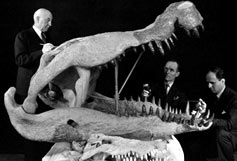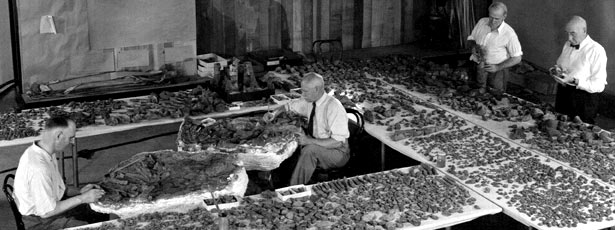Staff
Among the earliest publications to deal with paleontological preparation techniques are F.A. Bather’s Preparation and Preservation of Fossils (1908) and A. Hermann’s review paper entitled Modern Laboratory Methods in Vertebrate Palaeontology (1909). These publications recognized that a preparator (a term apparently first used in North America) should have certain special attributes, but no longer a general background of coal mining, quarrying, or stonemasonry.
These special attributes included a thorough knowledge of anatomy; unusual manual dexterity and patience; and the ability to think several decades ahead in order to ensure that the materials used would be stable in a museum environment far into the future. Finally, for work in the field, the preparator needed to have knowledge of geology and sedimentology so that the most suitable methods of discovering and removing fossils could be applied during expeditions. (For more on this, download Brinkman and Whybrow’s articles below.)
A staff of skilled and experienced technicians was the most vital ingredient for operating an efficient fossil preparation lab, but finding the right preparators and retaining their services for the long term was not easy. In the early 20th century there were two schools of thought on how to find the best preparators. One approach was to find staff with little or no experience with fossils, but with good mechanical skills, and then train them in preparation techniques.
Another tactic adopted by museum paleontologists was to train the collectors who did fieldwork in the summer. These workers would then spend the winter months in the fossil preparation lab working on many of the same fossils that they had collected earlier. Valuable experience gained in the lab was later applied in the field, often yielding better results and higher standards for fieldwork. Collectors made better judgments about which fossils to collect, and learned firsthand the value of keeping careful field notes, drawing accurate quarry diagrams, and carefully packing and labeling all packages from the field.
Preparators also advised fieldworkers on better collecting techniques. At the AMNH, paleontologist Henry Fairfield Osborn advised some of his collectors to be sure to apply a separating layer of linen or paper between the bone and the protective plaster jacket – plaster applied directly to friable specimens had a tendency to pull off and damage pieces of bone when the jacket was removed in the lab. Later, in 1902 he admonished another to provide a complete packing list when shipping fossils back from the field, in order that preparators might find pieces in the order in which they were required.
As might be expected, there were sometimes conflicts between those working in the lab and those collecting specimens in the field.
Barnum Brown
(1873-1963)
Although Barnum Brown began graduate study at Columbia University it became apparent to him that his love and talent was for collecting rather than research. Brown was one of the most prolific fossil prospectors of all time and under Henry Fairfield Osborn’s patronage at the American Museum of Natural History procured huge collections of specimens from sites such as Como Bluff, Wyoming; Patagonia, South America; the Badlands of Montana; and the Red Deer River in Alberta, Canada. Brown’s talents were not just in locating rich fossil beds but also in extricating the fossils and transporting them, some of them weighing up to two tons, hundreds of miles to the nearest railroad. His excavation techniques ranged from the standard pickaxes and chisels, to the novel (at that time) use of dynamite.

“You will be very much disappointed that the Dinosaur which you collected with so much care and labor has proved almost valueless. We have developed block after block in the hope of finding something of value; but in vain. I have directed Mr. Hermann to abandon work on the specimen, and to move the block down to the basement, although it is hardly worth keeping at all. …This seems to warn us that we should certainly examine material a little more carefully in the field before taking it up…. I know you sent the specimen to us after the best possible methods; but it should have received a more careful examination. I therefore request you to examine all your prospects and bones pretty carefully, so as to make yourself absolutely sure that we are not bringing on material that will not pay the shipment much less the heavy expense of collection.” (Letter, H.F. Osborn to Barnum Brown, 25, July 1902, DVP Archive, AMNH)
Of course, the specimen had not turned out to be as important as expected, which is a risk inherent in fieldwork. Osborn’s admonition flatly contradicted his Chief Preparator, Adam Hermann’s advice “that it is a great fault on the part of some fossil collectors to free the bones too much from the matrix, for this weakens the specimens and makes them more difficult to transport.” (Hermann, 1909, p. 286).
Resources
- Much of this page’s text was excerpted from Paul Brinkman’s 2009 paper “Dinosaurs, Museums, And The Modernization of American Fossil Preparation At The Turn Of The 20th Century”. To read more in depth about the development of fossil preparation at the American Museum of Natural History, The Chicago Field Museum and Pittsburgh’s Carnegie Museum download the complete text here.
- Download Adam Hermann’s articles to learn more about his techniques and materials:
- Download a copy of Peter Whybrow’s 1985 article on the History of Fossil Collecting and Preparation Techniques here.
- Visit the Academy of Natural Sciences’ online exhibit on Joseph Leidy and learn more about the challenges of early collecting and fossil preparation.
- Access archive images of expeditions, field notebooks and portraits from the American Museum of Natural History’s Division of Paleontology collections archive page.
- View additional historical images on exhibitions and expeditions from the American Museum of Natural History’s archives.
Bibliography
Aaseng, Nathan. 1996. American Dinosaur Hunters. Springfield, NJ: Enslow.
Brinkman, P. 2009. “Modernizing American fossil preparation at the turn of the 20th century”. Methods in Fossil Preparation: Proceedings of the First Annual Fossil Preparation and Collections Symposium, Brown, M.A., Kane, J.F., and Parker W.G. Eds. pp.21-34.
Brinkman, Paul D., 2000. “Establishing vertebrate paleontology at Chicago’s Field Columbian Museum, 1893-1898”. Archives of Natural History 27:1 pp.81-114.
Colbert, Edwin H. 1984. The Great Dinosaur Hunters and Their Discoveries. New York: Dover.
Hermann, Adam, 1909. “Modern Laboratory Methods in Vertebrate Paleontology”, Bulletin of the American Museum of Natural History 26, pp. 283-331.
Hermann, Adam, 1908. “Modern Methods of Excavating, Preparing and Mounting Fossil Skeletons”, The American Naturalist 42:493 pp. 43-47.
Kissel, Richard A. 2007. “The Sauropod Chronicles” Natural History April pp. 34-38.
Osborn, Henry F. 1904. “On the Use of the Sandblast in Cleaning Fossils” Science n.s.19 no:476 p.256.
Riggs, Elmer S. 1903. “The Use of Pneumatic Tools in the Preparation of Fossils”, Science n.s. 17 no 436. pp. 747-749.
Rixon, A.E., 1976. Fossil Animal Remains: Their Preparation and Conservation. London: Athlone Press.
Spalding, David A.E. 1993. Dinosaur Hunters. Rocklin, CA: Prima.
Whybrow, Peter J. 1985. “A History of Fossil Collecting and Preparation Techniques” Curator 28:1 pp. 5-26.


